Bosch 11304 User Manual
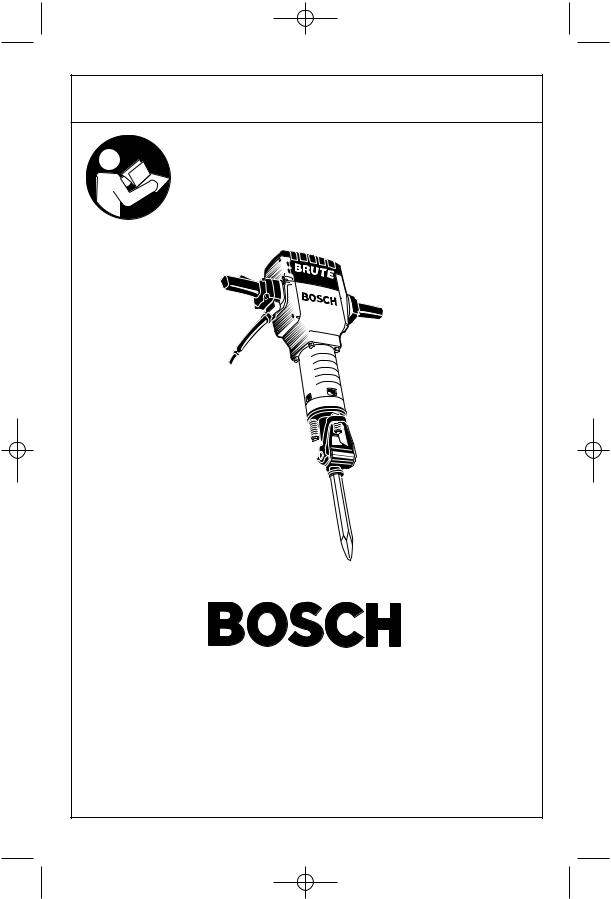
BM 1619929522 12/02 12/10/02 3:43 PM Page 1
IMPORTANT: |
IMPORTANT : |
IMPORTANTE: |
Read Before Using |
Lire avant usage |
Leer antes de usar |
Operating/Safety Instructions
Consignes de fonctionnement/sécurité
Instrucciones de funcionamiento y seguridad
11304
Consumer Information
Renseignement des consommateurs
Información para el consumidor
Toll Free Number: |
Appel gratuit : |
Número de teléfono gratuito: |
1-877-BOSCH99 (1-877-267-2499) http://www.boschtools.com |
||
|
|
|
For English |
Parlez-vous français? |
¿Habla español? |
See page 2 |
Voir page 9 |
Ver página 16 |
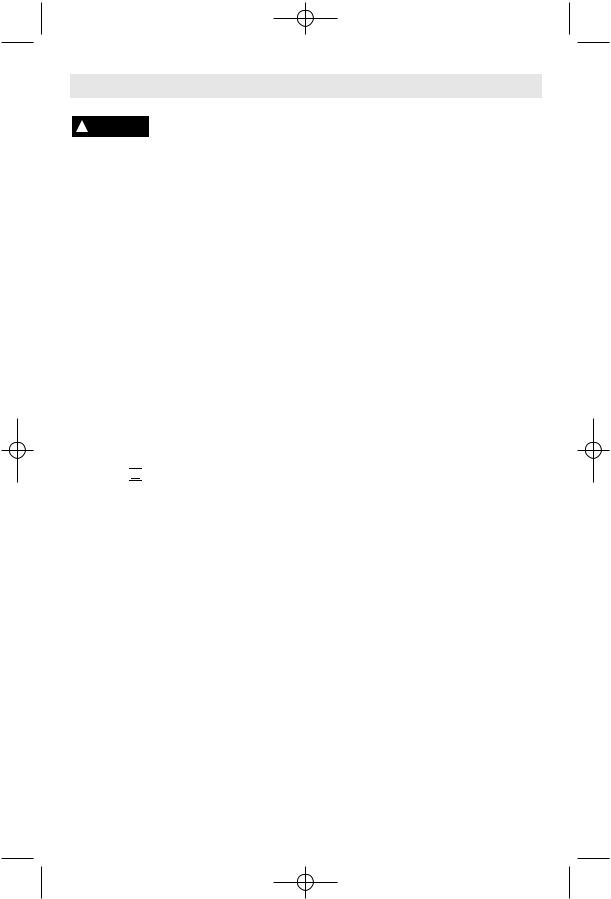
BM 1619929522 12/02 12/10/02 3:43 PM Page 2
Power Tool Safety Rules
! WARNING Read and understand all instructions. Failure to follow all instructions listed below, may result in electric shock, fire and/or serious personal injury.
SAVE THESE INSTRUCTIONS
Work Area
Keep your work area clean and well lit.
Cluttered benches and dark areas invite accidents.
Do not operate power tools in explosive atmospheres, such as in the presence of flammable liquids, gases, or dust. Power tools create sparks which may ignite the dust or fumes.
Keep by-standers, children, and visitors away while operating a power tool.
Distractions can cause you to lose control.
Electrical Safety
Double Insulated tools are equipped with a polarized plug (one blade is wider than the other.) This plug will fit in a polarized outlet only one way. If the plug does not fit fully in the outlet, reverse the plug. If it still does not fit, contact a qualified electrician to install a polarized outlet. Do not change the plug in any way. Double Insulation 


 eliminates the need for the three wire grounded power cord and grounded power supply system. Before plugging in the tool, be certain the outlet voltage supplied is within the voltage marked on the nameplate. Do not use “AC only” rated tools with a DC power supply.
eliminates the need for the three wire grounded power cord and grounded power supply system. Before plugging in the tool, be certain the outlet voltage supplied is within the voltage marked on the nameplate. Do not use “AC only” rated tools with a DC power supply.
Avoid body contact with grounded surfaces such as pipes, radiators, ranges and refrigerators. There is an increased risk of electric shock if your body is grounded. If operating the power tool in damp locations is unavoidable, a Ground Fault Circuit Interrupter must be used to supply the power to your tool. Electrician’s rubber gloves and footwear will further enhance your personal safety.
Don't expose power tools to rain or wet conditions. Water entering a power tool will increase the risk of electric shock.
Do not abuse the cord. Never use the cord to carry the tools or pull the plug from an outlet. Keep cord away from heat, oil, sharp edges or moving parts. Replace damaged cords immediately. Damaged cords increase the risk of electric shock.
When operating a power tool outside, use an outdoor extension cord marked "W-A" or "W." These cords are rated for outdoor use and reduce the risk of electric shock. Refer to “Recommended sizes of Extension Cords” in the Accessory section of this manual.
Personal Safety
Stay alert, watch what you are doing and use common sense when operating a power tool. Do not use tool while tired or under the influence of drugs, alcohol, or medication. A moment of inattention while operating power tools may result in serious personal injury.
Dress properly. Do not wear loose clothing or jewelry. Contain long hair. Keep your hair, clothing, and gloves away from moving parts. Loose clothes, jewelry, or long hair can be caught in moving parts. Keep handles dry, clean and free from oil and grease.
Avoid accidental starting. Be sure switch is “OFF” before plugging in. Carrying tools with your finger on the switch or plugging in tools that have the switch “ON” invites accidents.
Remove adjusting keys or wrenches before turning the tool “ON”. A wrench or a key that is left attached to a rotating part of the tool may result in personal injury.
Do not overreach. Keep proper footing and balance at all times. Proper footing and balance enables better control of the tool in unexpected situations.
Use safety equipment. Always wear eye protection. Dust mask, non-skid safety shoes, hard hat, or hearing protection must be used for appropriate conditions.
Tool Use and Care
Use clamps or other practical way to secure and support the workpiece to a stable platform. Holding the work by hand or against your body is unstable and may lead to loss of control.
-2-
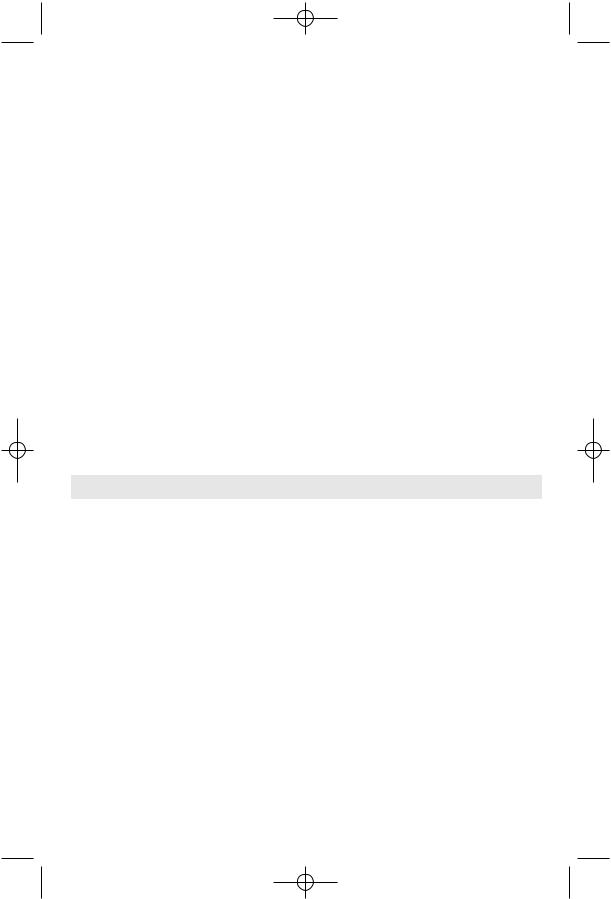
BM 1619929522 12/02 12/10/02 3:43 PM Page 3
Do not force tool. Use the correct tool for your application. The correct tool will do the job better and safer at the rate for which it is designed.
Do not use tool if switch does not turn it “ON” or “OFF”. Any tool that cannot be controlled with the switch is dangerous and must be repaired.
Disconnect the plug from the power source before making any adjustments, changing accessories, or storing the tool. Such preventive safety measures reduce the risk of starting the tool accidentally.
Store idle tools out of reach of children and other untrained persons. Tools are dangerous in the hands of untrained users.
Maintain tools with care. Keep cutting tools sharp and clean. Properly maintained tools, with sharp cutting edges are less likely to bind and are easier to control. Any alteration or modification is a misuse and may result in a dangerous condition.
Check for misalignment or binding of moving parts, breakage of parts, and any other condition that may affect the tools
operation. If damaged, have the tool serviced before using. Many accidents are caused by poorly maintained tools. Develop a periodic maintenance schedule for your tool.
Use only accessories that are recommended by the manufacturer for your model. Accessories that may be suitable for one tool, may become hazardous when used on another tool.
Service
Tool service must be performed only by qualified repair personnel. Service or maintenance performed by unqualified personnel could result in a risk of injury. For example: internal wires may be misplaced or pinched, safety guard return springs may be improperly mounted.
When servicing a tool, use only identical replacement parts. Follow instructions in the Maintenance section of this manual.
Use of unauthorized parts or failure to follow Maintenance Instructions may create a risk of electric shock or injury. Certain cleaning agents such as gasoline, carbon tetrachloride, ammonia, etc. may damage plastic parts.
Demolition Hammer Safety Rules
Hold tools by insulated gripping surfaces when performing an operation where the cutting tool may contact hidden wiring or it own cord. Contact with a "live" wire will make exposed metal parts of the tool "live" and shock the operator. Do not drill, fasten or break into existing walls or other blind areas where electrical wiring may exist. If this situation is unavoidable, disconnect all fuses or circuit breakers feeding this worksite.
Wear ear protectors when using the tool for extended periods. Prolonged exposure to high intensity noise can cause hearing loss.
Do not cut or drill into gas lines. Use a metal detector to determine if there are metal pipes hidden in the work area or call the local utility company for assistance before beginning the operation. Striking or cutting into a gas line will result in explosion.
Always use the side handle for maximum control over torque reaction or kick-back.
Never attempt to operate this tool with one hand. The slip clutch engages if you firmly control the tool during a torque reaction or kickback.
Always wear safety goggles or eye protection when using this tool. Use a dust mask or respirator for applications which generate dust. Safety goggles or eye protection will help deflect fragments of the material that may be thrown toward your face and eyes. Dust generated or gases released from the material you are cutting (i.e. asbestos insulated pipes, radon) may cause respiratory difficulties.
Use thick cushioned gloves and limit the exposure time by taking frequent rest periods. Vibration caused by hammer-drill action may be harmful to your hands and arms.
Position yourself to avoid being caught between the tool or side handle and walls
-3-
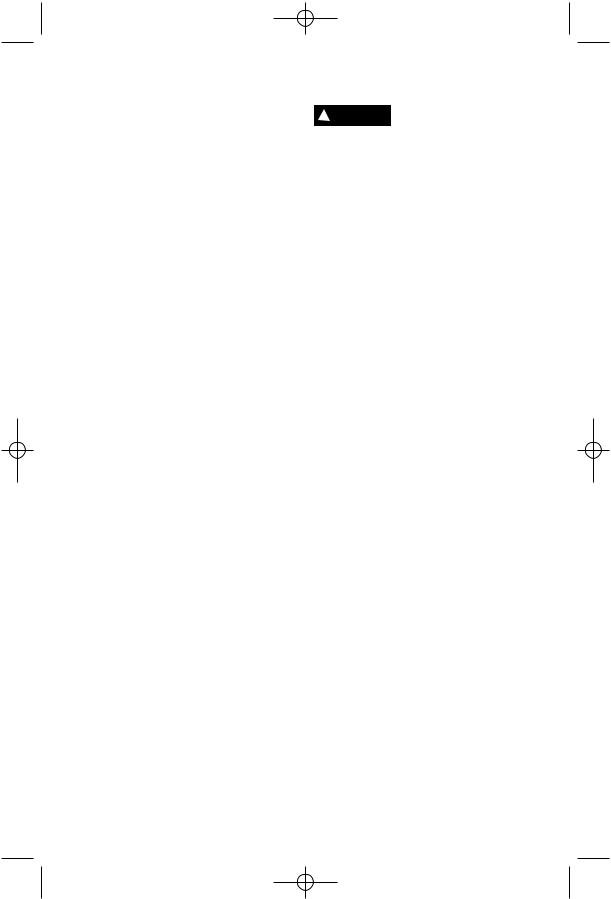
BM 1619929522 12/02 12/10/02 3:43 PM Page 4
or posts. Should the bit become bound or jammed in the work, the reaction torque of the tool could crush your hand or leg.
Do not strike the bit with a handheld hammer or sledge hammer when attempting to dislodge a bound or jammed bit. Fragments of metal from the bit could dislodge and strike you or bystanders.
Never place the tool down until the motor has come to a complete stop.
Do not use dull or damaged bits and accessories. Dull or damaged bits have a greater tendency to bind in the workpiece.
When removing the bit from the tool avoid contact with skin and use proper protective gloves when grasping the bit or accessory.
Accessories may be hot after prolonged use.
-4-
Some dust created by power sanding, sawing, grinding, drilling, and other construction
activities contains chemicals known to cause cancer, birth defects or other reproductive harm. Some examples of these chemicals are:
•Lead from lead-based paints,
•Crystalline silica from bricks and cement and other masonry products, and
•Arsenic and chromium from chemicallytreated lumber.
Your risk from these exposures varies, depending on how often you do this type of work. To reduce your exposure to these chemicals: work in a well ventilated area, and work with approved safety equipment, such as those dust masks that are specially designed to filter out microscopic particles.
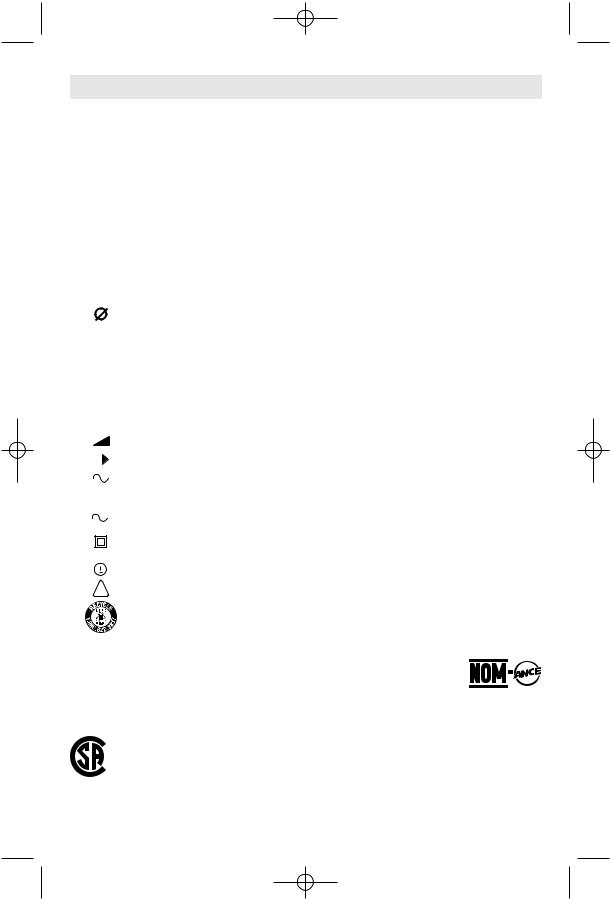
BM 1619929522 12/02 12/10/02 3:43 PM Page 5
Symbols
IMPORTANT: Some of the following symbols may be used on your tool. Please study them and learn their meaning. Proper interpretation of these symbols will allow you to operate the tool better and safer.
Symbol |
Name |
Designation/Explanation |
||||||||
|
|
|
|
|
|
|
|
|
|
|
|
|
|
|
V |
Volts |
Voltage (potential) |
||||
|
|
|
|
A |
Amperes |
Current |
||||
|
|
Hz |
Hertz |
Frequency (cycles per second) |
||||||
|
|
|
|
|
|
|
|
|
|
|
|
|
|
W |
Watt |
Power |
|||||
|
|
kg |
Kilograms |
Weight |
||||||
|
min |
Minutes |
Time |
|||||||
|
|
|
|
|
|
|
|
|
|
|
|
|
|
|
s |
Seconds |
Time |
||||
|
|
|
|
|
|
|
|
|
Diameter |
Size of drill bits, grinding wheels, etc. |
|
|
|
|
|
|
|
|
|
|
|
|
|
|
n0 |
No load speed |
Rotational speed, at no load |
|||||
.../min |
Revolutions or reciprocation per minute |
Revolutions, strokes, surface speed, |
||||||||
|
|
|
|
|
|
|
|
|
|
orbits etc. per minute |
0 |
|
|
|
Off position |
Zero speed, zero torque... |
|||||
1, 2, 3, ... |
Selector settings |
Speed, torque or position settings. |
||||||||
I, II, III, |
|
Higher number means greater speed |
||||||||
0 |
|
|
|
|
|
|
Infinitely variable selector with off |
Speed is increasing from 0 setting |
||
|
|
|
|
|
|
|
|
|
|
|
|
|
|
|
|
|
|
|
|
Arrow |
Action in the direction of arrow |
|
|
|
|
|
|
|
|
|
||
|
|
|
|
|
|
|
|
|
Alternating current |
Type or a characteristic of current |
|
|
|
|
|
|
|
|
|
|
|
|
|
|
|
|
|
|
|
|
Direct current |
Type or a characteristic of current |
|
|
|
|
|
|
|
|
|
||
|
|
|
|
|
|
|
|
|
|
|
|
|
|
|
|
|
|
|
|
Alternating or direct current |
Type or a characteristic of current |
|
|
|
|
|
|
|
|
|
||
|
|
|
|
|
|
|
|
|
Class II construction |
Designates Double Insulated |
|
|
|
|
|
|
|
|
|
||
|
|
|
|
|
|
|
|
|
|
Construction tools. |
|
|
|
|
|
|
|
|
|
|
|
|
|
|
|
|
|
|
|
|
Earthing terminal |
Grounding terminal |
|
|
|
|
|
|
|
|
|
||
|
|
|
|
|
|
|
|
|
|
|
|
|
|
|
|
|
|
|
|
Warning symbol |
Alerts user to warning messages |
|
|
|
|
|
|
|
|
|
||
|
|
|
|
|
|
|
|
|
||
|
|
|
|
|
|
|
|
|
Ni-Cad RBRC seal |
Designates Ni-Cad battery recycling |
|
|
|
|
|
|
|
|
|
|
program |
|
|
|
|
|
|
|
|
|
|
|
This symbol designates that this tool is listed by Underwriters Laboratories.
This symbol designates that this tool is listed by the Canadian Standards Association.
This symbol designates that this tool is listed to Canadian Standards by Underwriters Laboratories.
This symbol designates that this tool is listed by Underwriters Laboratories, and listed to Canadian Standards by Underwriters Laboratories.
This symbol designates that
this tool complies to NOM Mexican Standards.
-5-
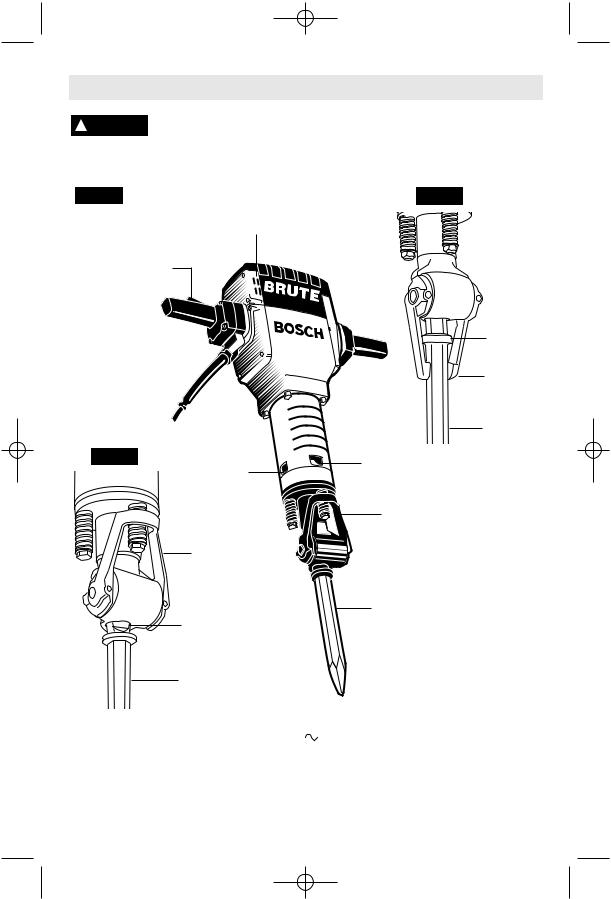
BM 1619929522 12/02 12/10/02 3:43 PM Page 6
Functional Description and Specifications
Disconnect the plug from the power source before making any assembly, adjustments or changing accessories. Such preventive safety
measures reduce the risk of starting the tool accidentally.
Demolition Hammer
FIG. 1 |
FIG. 2 |
AIR VENTS
PADDLE ON/OFF
SWITCH
COLLAR (Standard air steel)
TOOL
RETAINER
LEVER
STANDARD
AIR STEEL
FIG. 3 |
|
AIR VENTS |
AIR VENTS |
|
|
|
|
|
|
|
TOOL |
|
|
RETAINER |
|
|
LEVER |
TOOL |
|
|
RETAINER |
|
|
LEVER |
|
|
|
|
BOSCH |
NOTCH |
|
INTERNAL |
|
LOCKING |
|
(Bosch internal |
|
|
|
STEEL |
|
locking steel) |
|
|
|
|
|
BOSCH |
|
|
INTERNAL |
|
|
LOCKING |
|
|
STEEL |
|
|
Model number |
11304 |
|
Voltage rating |
120 V |
50 - 60Hz |
Amperage rating |
15.0 A |
|
No load speed |
n0 1,340/min |
|
Shank style |
Standard 1-1/8" hex, air tool steel |
|
|
or Bosch internal locking steel. |
|
-6-
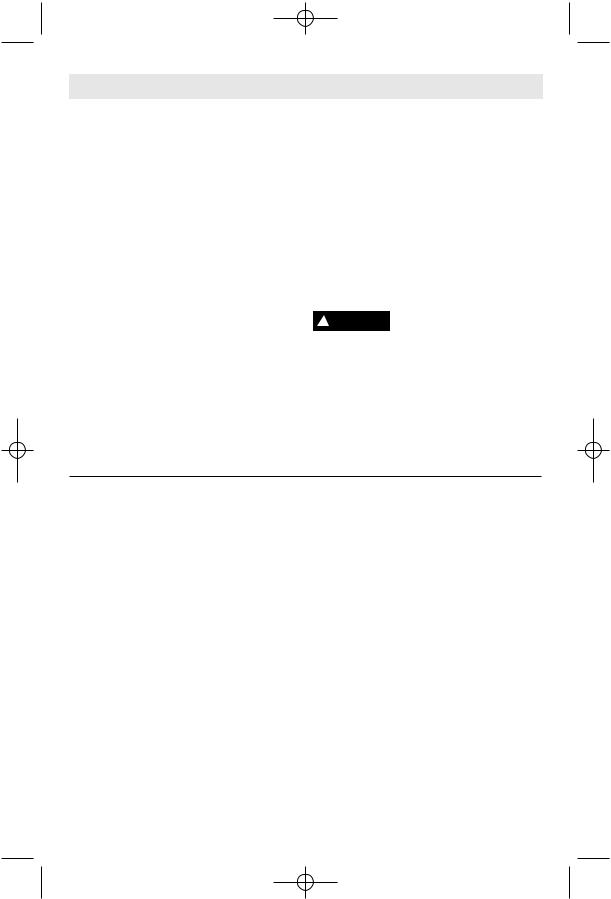
BM 1619929522 12/02 12/10/02 3:43 PM Page 7
Operating Instructions
PADDLE "ON/OFF" SWITCH
The paddle switch enables the operator to control the switch functions of "ON /OFF".
TO SWITCH THE TOOL "ON": Squeeze and hold the paddle lever. TO SWITCH THE TOOL "OFF ": Release pressure on the paddle lever. The switch is spring loaded and will return automatically.
INSTALLING ACCESSORIES
Clean the insert shank end of the accessory to remove any debris, then lightly grease with a light oil or lubricant. If work is to be done where the accessories are changed frequently and laid in dirt, sand or concrete dust, it is best not to grease the shank after wiping clean.
To lock standard air steel in place, lower the tool retainer lever all the way down and around the bottom and raise lever all the way up to the opposite side. To lock, insert air steel up to the striker and lower the retainer lever around the shank below the accessory collar as shown in figure 2.
To lock Bosch internal locking steel in place, lower tool retainer until you can slide the internal locking steel up to the striker. NOTE: notch on internal locking steel should always face toward the retainer lever. To lock, raise the tool retainer lever all the way up as shown in figure 3.
NOTE: The high efficiency available from the rotary hammers can only be obtained if sharp and undamaged accessories are used. The "cost" to maintain sharp and undamaged accessories is more than offset by the "time saved" in operating the tool with sharp accessories.
REMOVING ACCESSORIES
Accessories may be hot ! WARNING after use. Avoid contact
with skin and use proper protective gloves or cloth to remove.
To remove an accessory, reverse the previous directions. All accessories should be wiped clean after removing.
"TOOL TIPS"
The tool may be switched on with either hand. Balance the tool with both hands and rest the tool on the hip.
For the best penetration rates in concrete, run the tool with a steady pressure, but do not use excessive force as this will decrease the efficiency of the tool. Start chipping with the tool in a straight in position until the surface to be broken is chipped. Draw the hammer back at an angle of 60˚ with the surface to be broken. Apply only enough force to keep the tool weight on the accessory
All grease packed hammers require a short period of time to warm up. Depending on the room temperature, this time may vary from approximately 15 seconds (90˚F) to 2
minutes (32˚F). A new hammer requires a break-in period before full performance is realized. This period may require up to 5 hours of operation.
Avoid no load running of the tool. No load or "empty blows" is the most damaging factor to any impact hammer.
An electric hammer is likely to be the most expensive portable tool at the construction job. The long wear and efficient operation of the BOSCH hammers will more than justify the cost for tools of this type. As earlier pointed out, sharp accessories as well as clean air vents are necessary for efficient operation. Establish and follow a set maintenance program.
-7-
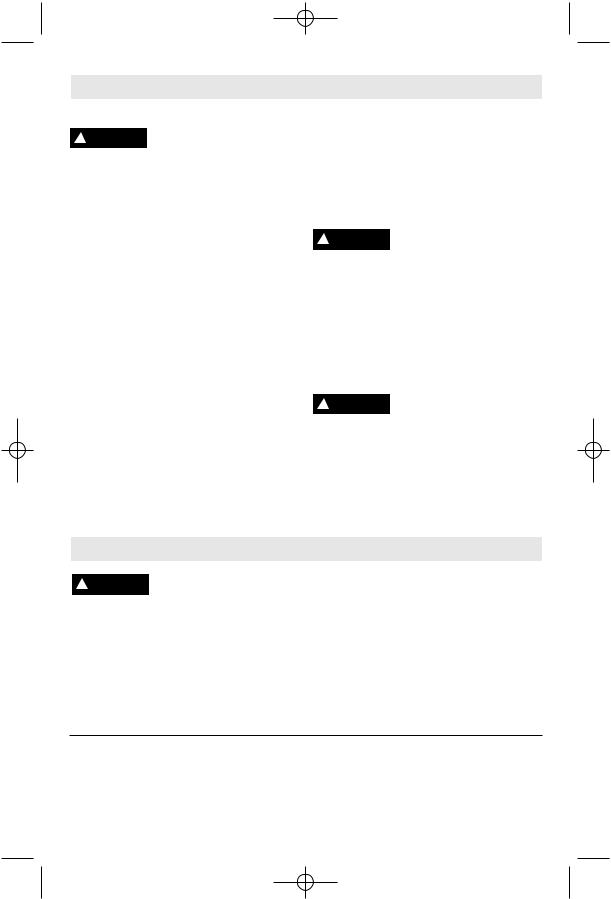
BM 1619929522 12/02 12/10/02 3:43 PM Page 8
Maintenance
Service
Preventive maintenance performed by unauthorized personnel may result in misplacing of
internal wires and components which could cause serious hazard. We recommend that all tool service be performed by a Bosch Factory Service Center or Authorized Bosch Service Station.
TOOL LUBRICATION
Your Bosch tool has been properly lubricated and is ready to use. It is recommended that tools with gears be regreased with a special gear lubricant at every brush change.
CARBON BRUSHES
The brushes and commutator in your tool have been engineered for many hours of dependable service.
Your tool is equipped with a Pop-out brush system. The tool will shut off when brush replacement, lubrication and preventive maintenance are needed.
Only genuine Bosch replacement brushes specially designed for your tool should be used.
BEARINGS
Every second brush change, the bearings should be replaced at Bosch Factory Service Center or Authorized Bosch Service Station. Bearings which become noisy (due to heavy load or very abrasive material cutting) should be replaced at once to avoid overheating or motor failure.
Cleaning
To avoid accidents always disconnect the tool from the power supply before cleaning or
performing any maintenance. The tool may be cleaned most effectively with compressed dry air. Always wear safety goggles when cleaning tools with compressed air.
Ventilation openings and switch levers must be kept clean and free of foreign matter. Do not attempt to clean by inserting pointed objects through openings.
Certain cleaning agents and solvents damage plastic parts. Some of these are: gasoline,
carbon tetrachloride, chlorinated cleaning solvents, ammonia and household detergents that contain ammonia.
Accessories
If an extension cord is necessary, a cord with adequate size conductors that is capable
of carrying the current necessary for your tool must be used. This will prevent excessive voltage drop, loss of power or overheating. Grounded tools must use 3- wire extension cords that have 3-prong plugs and receptacles.
NOTE: The smaller the gauge number, the heavier the cord.
RECOMMENDED SIZES OF EXTENSION CORDS 120 VOLT ALTERNATING CURRENT TOOLS
Tool’s |
Cord Size in A.W.G. |
Wire Sizes in mm2 |
|||||||
|
|
|
|
|
|
|
|
||
Ampere |
|
|
|
|
|
|
|
|
|
Cord Length in Feet |
Cord Length in Meters |
||||||||
Rating |
|||||||||
|
25 |
50 |
100 |
150 |
15 |
30 |
60 |
120 |
|
3-6 |
|
|
|
|
|
|
|
|
|
18 |
16 |
16 |
14 |
.75 |
.75 |
1.5 |
2.5 |
||
6-8 |
18 |
16 |
14 |
12 |
.75 |
1.0 |
2.5 |
4.0 |
|
8-10 |
18 |
16 |
14 |
12 |
.75 |
1.0 |
2.5 |
4.0 |
|
10-12 |
16 |
16 |
14 |
12 |
1.0 |
2.5 |
4.0 |
— |
|
12-16 |
14 |
12 |
— |
— |
— |
— |
— |
— |
|
|
|
|
|
|
|
|
|
|
|
* Hammer hauler (Model 11304K only)
(*= standard equipment) (**= optional accessories)
-8-
